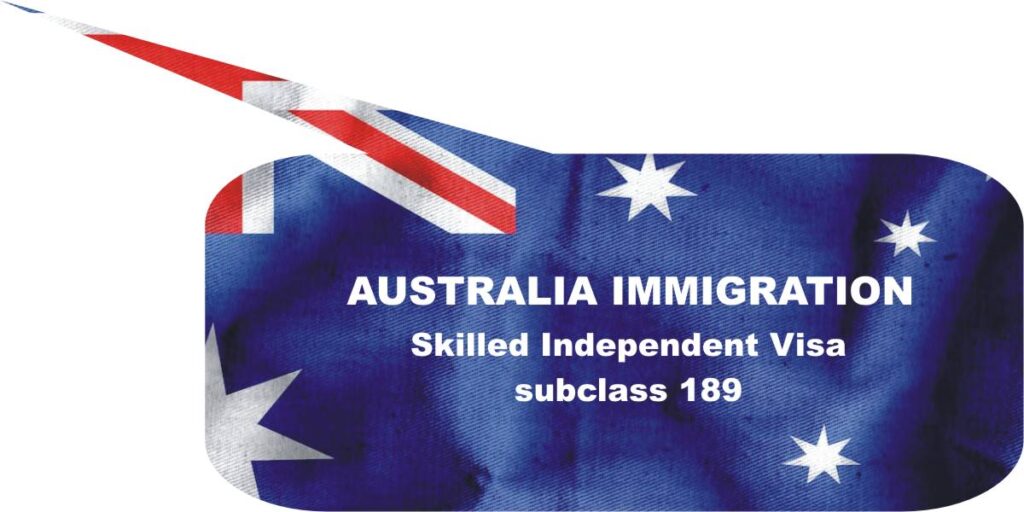Australia PR-189-Skilled Independent (Subclass 189)

The Skilled Independent Subclass 189 Visa is a popular pathway for skilled workers who want to immigrate to Australia. It is a permanent resident visa that allows skilled individuals to live, work, and study in Australia without the need for sponsorship from an employer, family member, or a state/territory government.
Here are some key points about the Subclass 189 Visa:
Points-Based System: To be eligible for this visa, applicants need to meet certain requirements and obtain a minimum number of points in Australia’s skilled migration points-based system. Points are awarded based on factors such as age, English language proficiency, work experience, education, and more.
Occupation List: Applicants must nominate an occupation from the Skilled Occupation List (SOL) or the Consolidated Sponsored Occupation List (CSOL) and meet the skills and qualifications requirements for that occupation.
Expression of Interest (EOI): To apply for a Subclass 189 Visa, you need to submit an Expression of Interest (EOI) through the SkillSelect system. This system helps manage and prioritize applications based on the points score and other factors.
Invitation to Apply: If you are successful in the SkillSelect system and have a competitive points score, you may receive an invitation to apply for the Subclass 189 Visa.
Age Limit: There is an age limit for this visa, typically 45 years at the time of invitation.
Health and Character Requirements: Applicants and their family members must meet health and character requirements to be granted the visa.
Independent Assessment: Unlike some other Australian visas, the Subclass 189 Visa does not require sponsorship from an employer, family member, or a state/territory government. It is entirely based on the applicant’s qualifications, skills, and points score.
Permanent Residency: This visa grants permanent residency in Australia, which means you can live and work in the country indefinitely, access social benefits, and eventually apply for Australian citizenship if you meet the eligibility criteria.
Residence Obligations: Once granted, you are expected to live in Australia for at least 2 years out of the 5 years following the grant of the visa. This helps ensure that the visa holder maintains their commitment to living in Australia as a permanent resident.
Benefits: As a Subclass 189 Visa holder, you and your family members can access various social services in Australia, such as healthcare and education, just like Australian citizens.
The Subclass 189 Visa is a competitive visa category, and the eligibility criteria and point requirements may change over time. It’s essential to stay updated with the latest information on the Australian Department of Home Affairs website or consult with a registered migration agent for personalized advice and guidance through the application process.
Obtaining a Skilled Independent Subclass 189 Visa in Australia involves several steps. Here is an overview of the process:
- Skills Assessment: The first step is to have your qualifications and skills assessed by a designated assessment body in Australia. This assessment ensures that your qualifications and work experience match the requirements for the nominated occupation on the Skilled Occupation List (SOL) or the Consolidated Sponsored Occupation List (CSOL).
- English Language Proficiency: You must demonstrate your English language proficiency by taking an approved English language test, such as IELTS, TOEFL, or PTE. You need to meet the minimum required score for your visa application.
- Expression of Interest (EOI): You need to submit an Expression of Interest (EOI) through the SkillSelect system. In your EOI, you’ll provide information about your skills, qualifications, work experience, English language proficiency, and other relevant details. You should also indicate your preference for the Subclass 189 Visa.
- Points Test: To be eligible for a Subclass 189 Visa, you need to score a minimum of 65 points in Australia’s skilled migration points test. Points are awarded based on various factors such as age, work experience, English language proficiency, education, and more.
- Wait for an Invitation: Once you’ve submitted your EOI, the Australian government will review your application and rank it based on your points score and other factors. If your EOI receives a high enough ranking, you may receive an invitation to apply for the Subclass 189 Visa.
- Visa Application: If you receive an invitation, you can proceed to submit a formal visa application within the specified time frame. You will need to provide all required documents and pay the visa application fee.
- Health and Character Checks: As part of the visa application process, you and your family members will be required to undergo health and character assessments. You must meet the health and character requirements to be granted the visa.
- Visa Grant: If your visa application is successful, you will be granted the Subclass 189 Visa, which is a permanent resident visa. This allows you to live, work, and study in Australia indefinitely.
- Residence Obligations: After obtaining the visa, you are required to live in Australia for at least 2 years out of the 5 years following the grant of the visa to maintain your permanent resident status.
Enjoy the Benefits: As a Subclass 189 Visa holder, you and your family members can access various social services in Australia, including healthcare and education, and you can eventually apply for Australian citizenship if you meet the eligibility criteria.
It’s important to note that the eligibility criteria, points system, and requirements for the Subclass 189 Visa may change over time. Therefore, it’s crucial to stay informed about the latest updates and consult with a registered migration agent or the Australian Department of Home Affairs for the most current information and guidance during the application process.


